Recovery of Palladium and Silver from Copper Sludge and Spent Petrochemical Catalysts via Effective Pyrometallurgical Processing
Abstract
:1. Introduction
2. Experimental Procedure
3. Results and Discussion
4. Conclusions
- Effective separation of slag and metal is essential for maximizing metal recovery rate, which requires a high settling velocity of metal droplets. This study demonstrates that slag viscosity significantly influences settling velocity, with lower viscosity facilitating higher settling velocity, and thus more efficient phase separation and metal recovery.
- As the mixing ratio of SPC increases from 10% to 30%, the recovery rate of Pd and Ag sharply decreases to 62.1% and 91.0%, respectively. This is attributed to the increase in slag viscosity as well as to the higher sulfur content in the metal phase, resulting in a decrease in the slag–metal interfacial tension. The lower interfacial tension enhances the instability of the interface, resulting in an emulsification of copper droplets in the slag phase, and hence hindering the metal–slag separation, ultimately decreasing the recovery of Pd and Ag.
- Even though the chemical solubility of target precious metals (i.e., chemical loss) decreases with the decreasing value of the CaO/Al2O3 ratio of the slag (i.e., with increasing SPC mixing ratio), an increase in the viscosity of the slag, and thus lower settling velocity of metal particles in slag phase (e.g., 0.1 mm/s for 50 μm diameter droplets for 30% SPC mixing with slag viscosity of 2.5 Poise). results in the higher physical loss. Hence, from the present experimental findings, physical loss is a much more dominant factor affecting the metal recovery rate rather than chemical loss.
Author Contributions
Funding
Data Availability Statement
Conflicts of Interest
References
- Balde, C.P.; Kuehr, R.; Yamamoto, T.; McDonald, R.; D’Angelo, E.; Althaf, S. The Global E-Waste Monitor 2024; International Telecommunication Union, United Nations Institute for Training and Resources: Bonn, Germany; Geneva, Switzerland, 2024. [Google Scholar]
- Krishnan, S.; Zulkapli, N.S.; Kamyab, H.; Taib, S.M.; Din, M.F.B.M.; Abd Majid, Z.; Chaiprapat, S.; Kenzo, I.; Ichikawa, Y.; Nasrullah, M.; et al. Current technologies for recovery of metals from industrial wastes: An overview. Environ. Technol. Innov. 2021, 22, 101525. [Google Scholar] [CrossRef]
- Meskers, C.E.; Hagelüken, C. Closed loop WEEE recycling? Challenges and opportunities for a global recycling society. In Proceedings of the 2009 EPD Congress, San Francisco, CA, USA, 15–19 February 2009; Wiley: Hoboken, NJ, USA, 2009. [Google Scholar]
- Reck, B.K.; Graedel, T.E. Challenges in metal recycling. Science 2012, 337, 690–695. [Google Scholar] [CrossRef]
- Schluep, M.; Hagelüken, C.; Kuehr, R.; Magalini, F.; Maurer, C.; Meskers, C.; Thiébaud, E.; Wang, F. Recycling—From E-Waste to Resources; United Nations Environment Programme & United Nations University: Berlin, Germany, 2009; pp. 41–50. [Google Scholar]
- Yatoo, A.M.; Hamid, B.; Sheikh, T.A.; Ali, S.; Bhat, S.A.; Ramola, S.; Ali, M.N.; Baba, Z.A.; Kumar, S. Global perspective of municipal solid waste and landfill leachate: Generation, composition, eco-toxicity, and sustainable management strategies. Environ. Sci. Pollut. Res. Int. 2024, 31, 23363–23392. [Google Scholar] [CrossRef]
- Avarmaa, K.; O’Brien, H.; Johto, H.; Taskinen, P. Equilibrium distribution of precious metals between slag and copper matte at 1250–1350 °C. J. Sustain. Metall. 2015, 1, 216–228. [Google Scholar] [CrossRef]
- Wan, X.; Kleemola, L.; Klemettinen, L.; O’Brien, H.; Taskinen, P.; Jokilaakso, A. On the kinetic behavior of recycling precious metals (Au, Ag, Pt, and Pd) through copper smelting process. J. Sustain. Metall. 2021, 7, 920–931. [Google Scholar] [CrossRef]
- Jiang, Y.; Fan, X.; He, Y.; Sun, L.; Wu, N. Enrichment of Platinum Group Metals from Spent Automotive Catalyst Leaching Residue by a Combined Smelting and Wet Extraction Method. J. Sustain. Metall. 2023, 9, 1180–1189. [Google Scholar] [CrossRef]
- Ghodrat, M.; Rhamdhani, M.A.; Khaliq, A.; Brooks, G.; Samali, B. Thermodynamic analysis of metals recycling out of waste printed circuit board through secondary copper smelting. J. Mater. Cycles Waste Manag. 2018, 20, 386–401. [Google Scholar] [CrossRef]
- Park, J.H. Recovery of Au, Ag and Ni from PCB Wastes by CaF2-containing Slag. Resour. Recycl. 2011, 20, 58–64. [Google Scholar]
- Kim, B.S.; Lee, J.C.; Seo, S.P.; Park, Y.K.; Sohn, H.Y. A process for extracting precious metals from spent printed circuit boards and automobile catalysts. JOM 2004, 56, 55–58. [Google Scholar] [CrossRef]
- Park, H.S.; Han, Y.S.; Park, J.H. Massive recycling of waste mobile phones: Pyrolysis, physical treatment, and pyrometallurgical processing of insoluble residue. ACS Sustain. Chem. Eng. 2019, 7, 14119–14125. [Google Scholar] [CrossRef]
- Martinez, A.M.; Tang, K.; Sommerseth, C.; Osen, K.S. Extraction of platinum group metals from spent catalyst material by a novel pyro-metallurgical process. In Rare Metal Technology 2021; Springer: Berlin/Heidelberg, Germany, 2021; pp. 101–113. [Google Scholar]
- Terakado, O.; Saeki, T.; Irizato, R.; Hirasawa, M. Pyrometallurgical recovery of indium from dental metal recycling sludge by chlorination treatment with ammonium chloride. Mater. Trans. 2010, 51, 1136–1140. [Google Scholar] [CrossRef]
- Lee, B.D.; Jung, H.J.; Baek, U.H.; Hong, S.H.; Han, J.W.; Yoo, B.D.; Lee, J.C. Recovery of Valuable Metals Using Pyrometallurgical Treatment. J. Korean Soc. Geosystem Eng. 2010, 47, 628–646. [Google Scholar]
- Kim, T.S.; Park, J.H. Structure-viscosity relationship of low-silica calcium aluminosilicate melts. ISIJ Int. 2014, 54, 2031–2038. [Google Scholar] [CrossRef]
- Poe, B.T.; McMillan, P.F.; Cote, B.; Massiot, D.; Coutures, J.P. Structure and dynamics in calcium aluminate liquids: High-temperature 27Al NMR and Raman Spectroscopy. J. Am. Ceram. Soc. 1994, 77, 1832–1838. [Google Scholar] [CrossRef]
- McMillan, P.F.; Petuskey, W.T.; Cote, B.; Massiot, D.; Landron, C.; Coutures, J.P. A structural investigation of CaO-Al2O3 glasses via 27Al MAS-NMR. J. Non-Cryst. Solids 1996, 195, 261–271. [Google Scholar] [CrossRef]
- Kim, R.R.; Kim, H.J.; Park, H.S.; Park, J.H. Thermodynamics of Palladium Dissolution Behavior in FetO–SiO2–CaO–Al2O3–MgO Slag at 1873 K. Metall. Mater. Trans. B 2024, 55, 2664–2672. [Google Scholar] [CrossRef]
- Kang, Y.B.; Park, J.H. On the dissolution behavior of sulfur in ternary silicate slags. Metall. Mater. Trans. B 2011, 42, 1211–1217. [Google Scholar] [CrossRef]
- Park, J.H.; Park, G.H.; Lee, Y.E. Carbide capacity of CaO–SiO2–MnO slag for the production of manganese alloys. ISIJ Int. 2010, 50, 1078–1083. [Google Scholar] [CrossRef]
- Jang, D.Y.; Min, D.J. The thermodynamic behavior of copper in the CaO-B2O3 and BaO-B2O3 slag system. Metall. Mater. Trans. B 2011, 42, 1144–1149. [Google Scholar] [CrossRef]
- Kim, H.J.; Kim, R.R.; Park, H.S.; Park, J.H. Solubility of Gold in FeO–SiO2–CaO–Al2O3–MgO Slag for Smelting of Gold-Containing Secondary Resources. Metall. Mater. Trans. B 2025, 56, 333–341. [Google Scholar] [CrossRef]
- Poirier, D.R.; Geiger, G.H. Laminar flow and momentum equation. In Solutions Manual To Accompany Transport Phenomena in Materials Processing; Springer: Berlin/Heidelberg, Germany, 1994; pp. 39–75. [Google Scholar]
- Benson, M.; Bennett, C.R.; Harry, J.E.; Patel, M.K.; Cross, M. The recovery mechanism of platinum group metals from catalytic converters in spent automotive exhaust systems. Resour. Conserv. Recycl. 2000, 31, 1–7. [Google Scholar] [CrossRef]
- Duan, S.; Kim, T.S.; Cho, J.; Park, J.H. Thermodynamic and Kinetic Analysis of Non-Metallic Inclusions Evolution in Si-Killed 316L Stainless Steel with Various Refining Slags. Met. Mater. Int. 2024, 30, 3483–3496. [Google Scholar] [CrossRef]
- Jing, J.; Guo, Y.; Wang, S.; Chen, F.; Yang, L.; Yang, J.; Xu, F.; Yu, L. Melting Properties and Phase Composition Transformation of Ti-Bearing Electric Furnace Slags in CaO–SiO2–MgO–Al2O3–50%TiO2 System. Met. Mater. Int. 2024, 30, 2045–2056. [Google Scholar] [CrossRef]
- Khartcyzov, G.; Shevchenko, M.; Nekhoroshev, E.; Jak, E. Integrated Experimental and Thermodynamic Modelling Study of Phase Equilibria in the PbO-AlO1.5-SiO2 System in Air. Met. Mater. Int. 2025. [Google Scholar] [CrossRef]
- Seo, J.G.; Song, J.M.; Lee, D.Y.; Park, T.J.; Kwon, H.J. Effect of Al2O3 Content and Particle Size of Iron Ore on the Assimilation Characteristics of Sintered Ore. Korean J. Met. Mater. 2024, 62, 696–704. [Google Scholar] [CrossRef]
- Fan, X.; Huang, Y.; Han, J.; Gao, S.; Zhang, J.; Jiao, K.; Chen, Z. Viscosity and Structure Studies of Iron-Based Quaternary Melts: The Effect of S. Met. Mater. Int. 2024, 30, 1783–1793. [Google Scholar] [CrossRef]
- Li, Y.; Cheng, G.; Lu, J.; Long, H. Characteristics and Formation Mechanism of Ca–Mg–Al–Si–O+(Ca,Mn)S Duplex Inclusions in Ca–S Free-Cutting Steel. Met. Mater. Int. 2025, 31, 134–152. [Google Scholar] [CrossRef]
- Kim, J.; Jung, J.; Cheon, H.S.; Kim, B.J.; Lim, C.Y.; Kim, S.H.; Choi, Y.S. Effect of Solution Temperature and Quench Delay on the Microstructure and Mechanical Properties of an Extruded Al-Mg-Si-Cu-Mn alloy. Korean J. Met. Mater. 2024, 62, 132–141. [Google Scholar] [CrossRef]
- Choi, K.; Jung, H.Y. The Effects of Post-Weld Heat Treatment on the Microstructure and Mechanical Properties of 9% Ni Steel Weld Joint with Fe-Based Filler Material. Korean J. Met. Mater. 2023, 61, 669–678. [Google Scholar] [CrossRef]
- Chen, J.; Chen, L.; Wang, L. Modification of Desulfurization Slag for Hot Metal Bearing V-Ti and Industry Application. Metals 2025, 15, 245. [Google Scholar] [CrossRef]
- Lu, L.; Wang, F.; Wang, H.; Qiu, J.; Ping, X. Kinetic Analysis of Molten Oxide Reduction Using Bottom-Blown Hydrogen Injection. Metals 2024, 14, 1255. [Google Scholar] [CrossRef]
- Wang, H.; Liu, F.; Zeng, H.; Liao, J.; Wang, J.; Lai, C. Distribution Behavior of Impurities during the Hydrogen Reduction Ironmaking Process. Metals 2024, 14, 718. [Google Scholar] [CrossRef]
- Yan, Z.; Htet, T.T.; Hage, J.; Meijer, K.; Li, Z. HIsarna Process Simulation Model: Using FactSage with Macro Facility. Metall. Mater. Trans. B 2023, 54, 868–879. [Google Scholar] [CrossRef]
- Singha, P. Refining Contribution at Hotspot and Emulsion Zones of Argon Oxygen Decarburization: Fundamental Analysis Based upon the FactSage-Macro Program Approach. Metall. Mater. Trans. B 2024, 55, 2181–2193. [Google Scholar] [CrossRef]
- Yadav, S.; Srishilan, C.; Shukla, A.K. Thermodynamic Model of MIDREX Ironmaking Process Using FactSageTM and Macro Facility. Metall. Mater. Trans. B 2023, 54, 3508–3525. [Google Scholar] [CrossRef]
- Liu, P.; Gao, Y.; Liu, X.; Wang, Q.; Li, G. Effect of Applied Voltage on Melting and Wetting Behaviors of CaO-SiO2-MgO-Al2O3 slag on Alumina Substrate. Met. Mater. Int. 2024. [Google Scholar] [CrossRef]
- Fan, X.; Gao, S.; Zhang, J.; Jiao, K. High Temperature Melt Viscosity Prediction Model Based on BP Neural Network. Met. Mater. Int. 2024, 30, 2067–2076. [Google Scholar] [CrossRef]
- Chen, G.; Yang, J.; Li, Y.; He, S. Mathematical Simulation of Decarburization with CO2 Injection During RH Refining of Ultra-Low-Carbon Steel. Met. Mater. Int. 2025, 31, 167–181. [Google Scholar] [CrossRef]
- Assael, M.J.; Kalyva, A.E.; Antoniadis, K.D.; Banish, R.M.; Egry, I.; Wu, J.; Wakeham, W.A. Reference data for the density and viscosity of liquid copper and liquid tin. J. Phys. Chem. Ref. Data 2010, 39, 033105. [Google Scholar] [CrossRef]
- Keene, B.J.; Mills, K.C. Densities of molten slags (Chapter 8). In Slag Atlas, 2nd ed.; VDEh, Verlag Stahleisen GmbH: Düsseldorf, Germany, 1995; pp. 313–347. [Google Scholar]
- Richardson, F.D. Interfacial phenomena and metallurgical processes. Can. Metall. Q. 1982, 21, 111–119. [Google Scholar] [CrossRef]
- Sun, H.; Nakashima, K.; Mori, K. Influence of Slag Composition on Slag–Iron Interfacial Tension. ISIJ Int. 2006, 46, 407–412. [Google Scholar] [CrossRef]
- Tanaka, T.; Goto, H.; Nakamoto, M.; Suzuki, M.; Hanao, M.; Zeze, M.; Yamamura, H.; Yoshikawa, T. Dynamic Changes in Interfacial Tension Between Liquid Fe Alloy and Molten Slag Induced by Chemical Reactions. ISIJ Int. 2016, 56, 944–952. [Google Scholar] [CrossRef]
- Muhmood, L. A New Insight to Interfacial Phenomena Occurring at Slag-Metal Interfaces. Steel Res. Int. 2011, 82, 1375–1384. [Google Scholar] [CrossRef]
- Yang, S.; Liu, W.; Li, J. Motion of Solid Particles at Molten Metal–Liquid Slag Interface. JOM 2015, 67, 2993–3001. [Google Scholar] [CrossRef]
- Ni, P.; Tanaka, T.; Suzuki, M.; Nakamoto, M.; Jönsson, P.G. A Kinetic Model of Mass Transfer and Chemical Reactions at a Steel/Slag Interface under Effect of Interfacial Tensions. ISIJ Int. 2019, 59, 737–748. [Google Scholar] [CrossRef]
- Rhamdhani, M.A.; Coley, K.S.; Brooks, G.A. Analysis of the source of dynamic interfacial phenomena during reaction between metal droplets and slag. Metall. Mater. Trans. B 2005, 36, 591–604. [Google Scholar] [CrossRef]
- Suzuki, M.; Nakamoto, M.; Tanaka, T.; Tsukaguchi, Y.; Mishima, K.; Hanao, M. Effect of Sulfur in Slag on Dynamic Change Behavior of Liquid Iron/Molten Slag Interfacial Tension. ISIJ Int. 2020, 60, 2332–2338. [Google Scholar] [CrossRef]
- Muhmood, L.; Viswanathan, N.N.; Seetharaman, S. Some Investigations into the Dynamic Mass Transfer at the Slag–Metal Interface Using Sulfur: Concept of Interfacial Velocity. Metall. Mater. Trans. B 2011, 42, 460–470. [Google Scholar] [CrossRef]
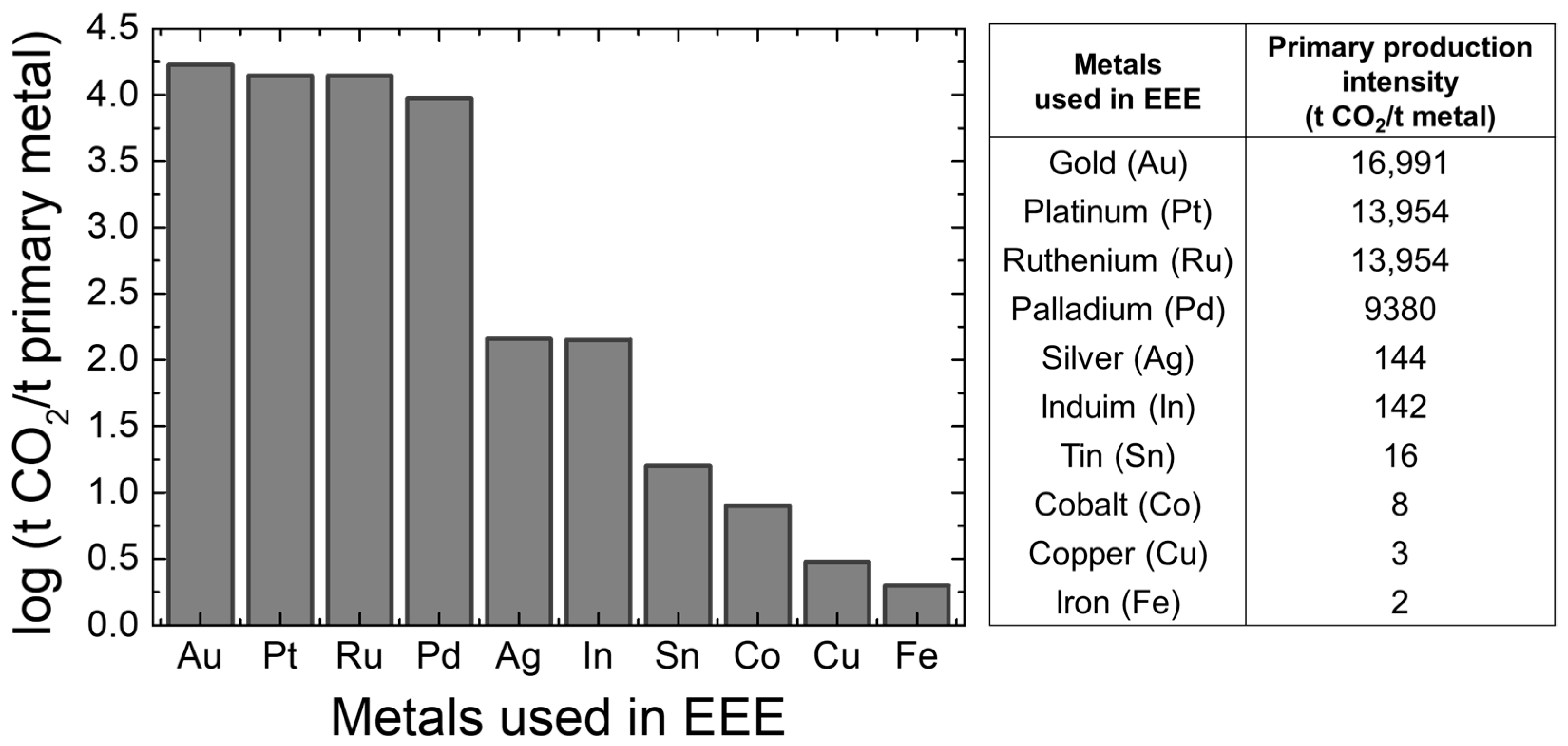


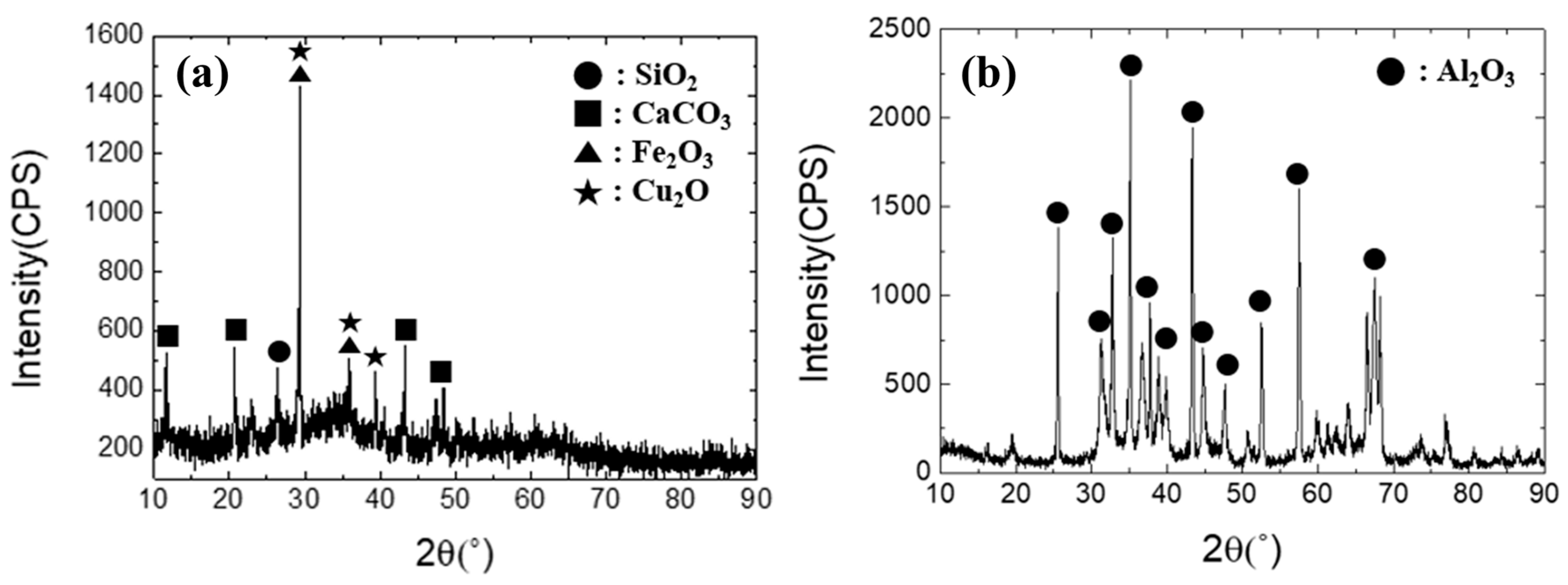
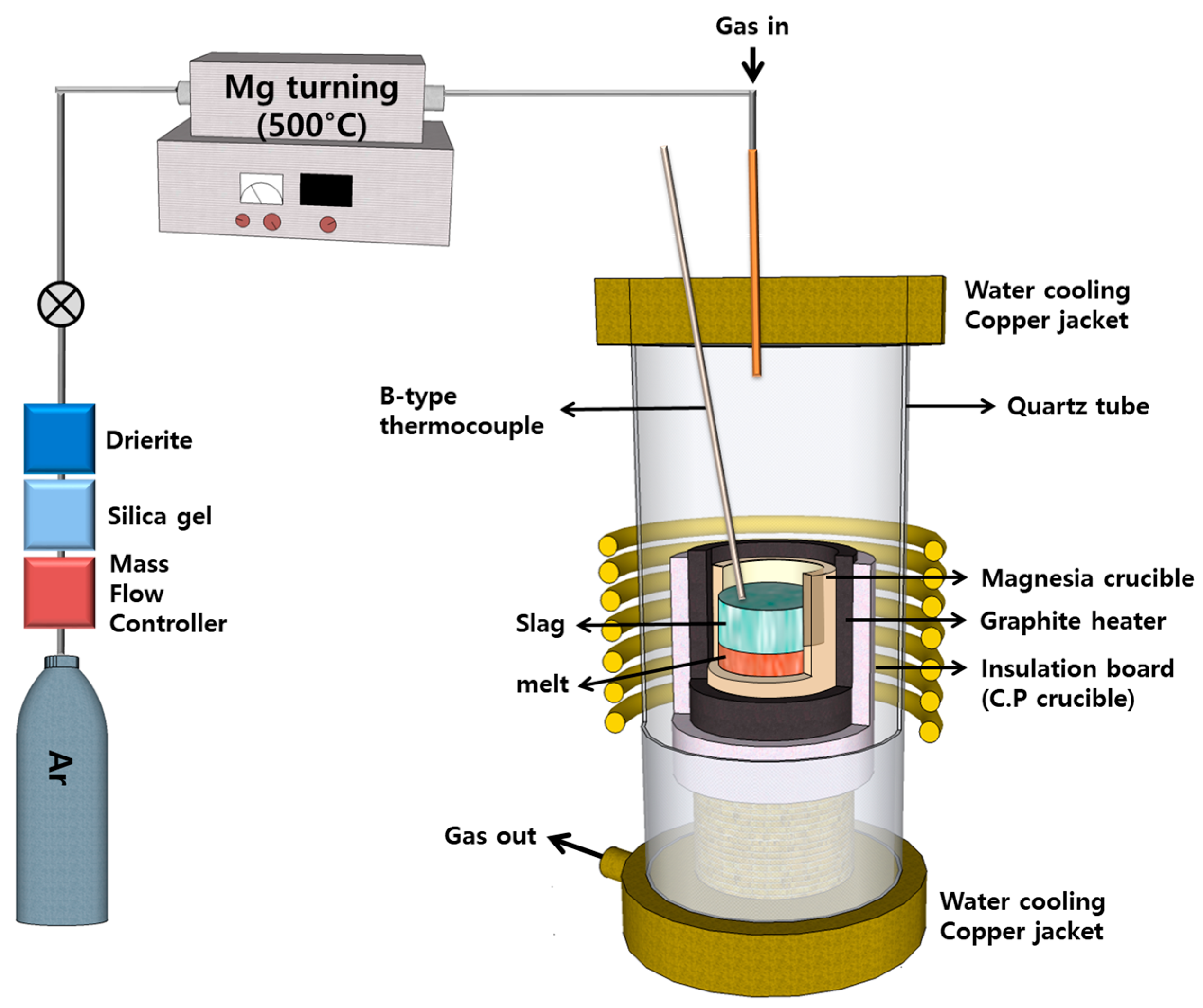

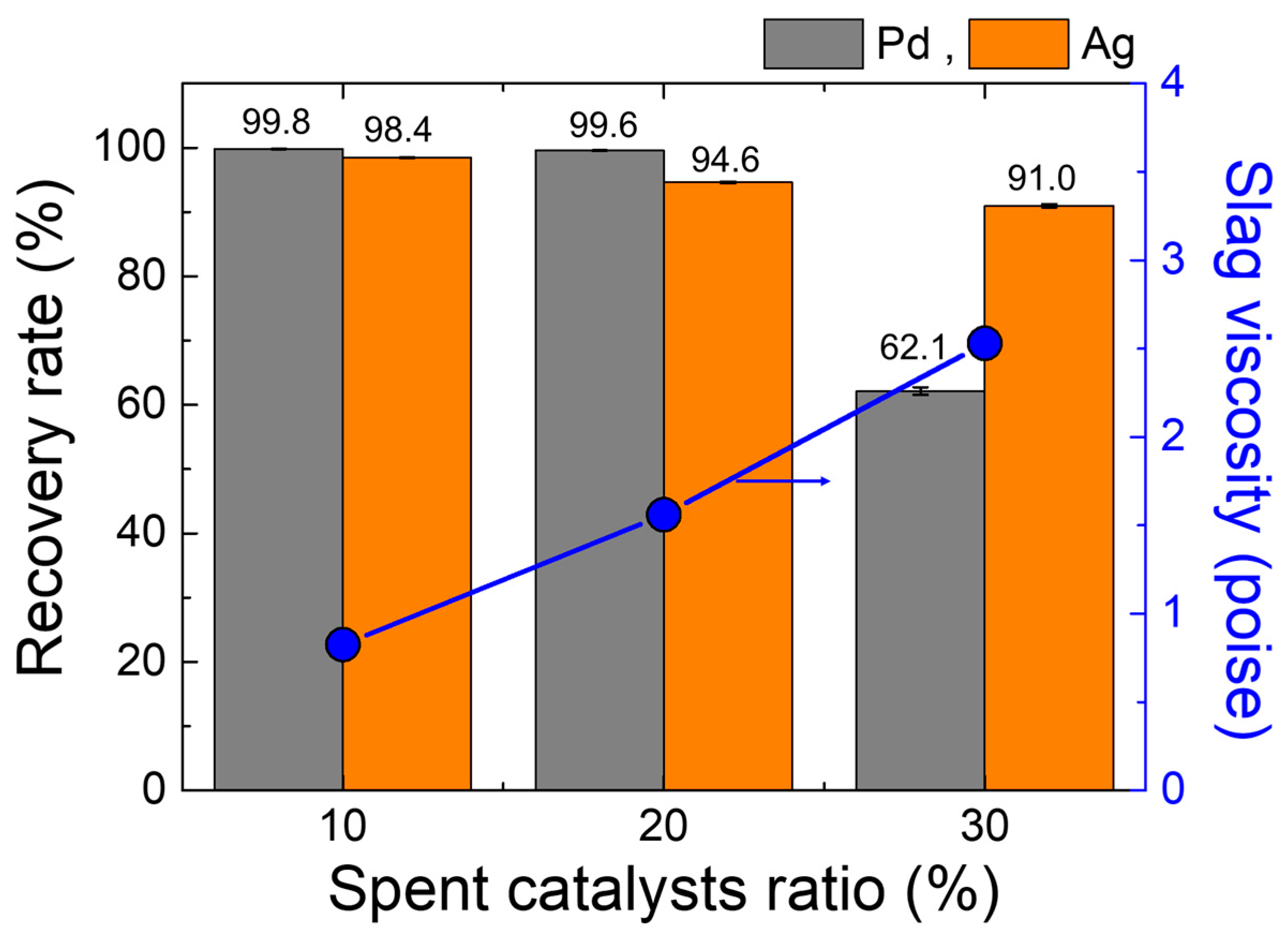
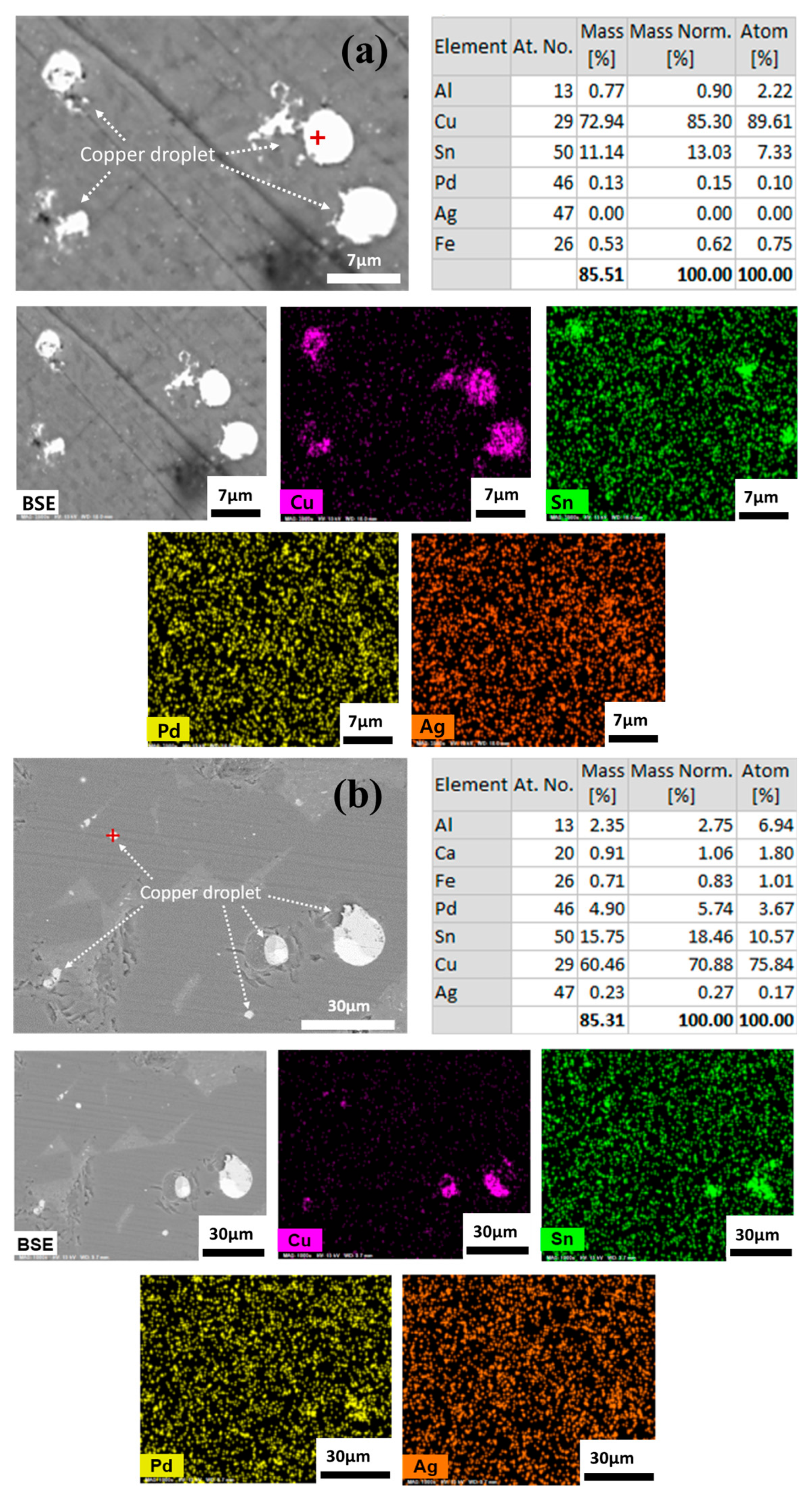
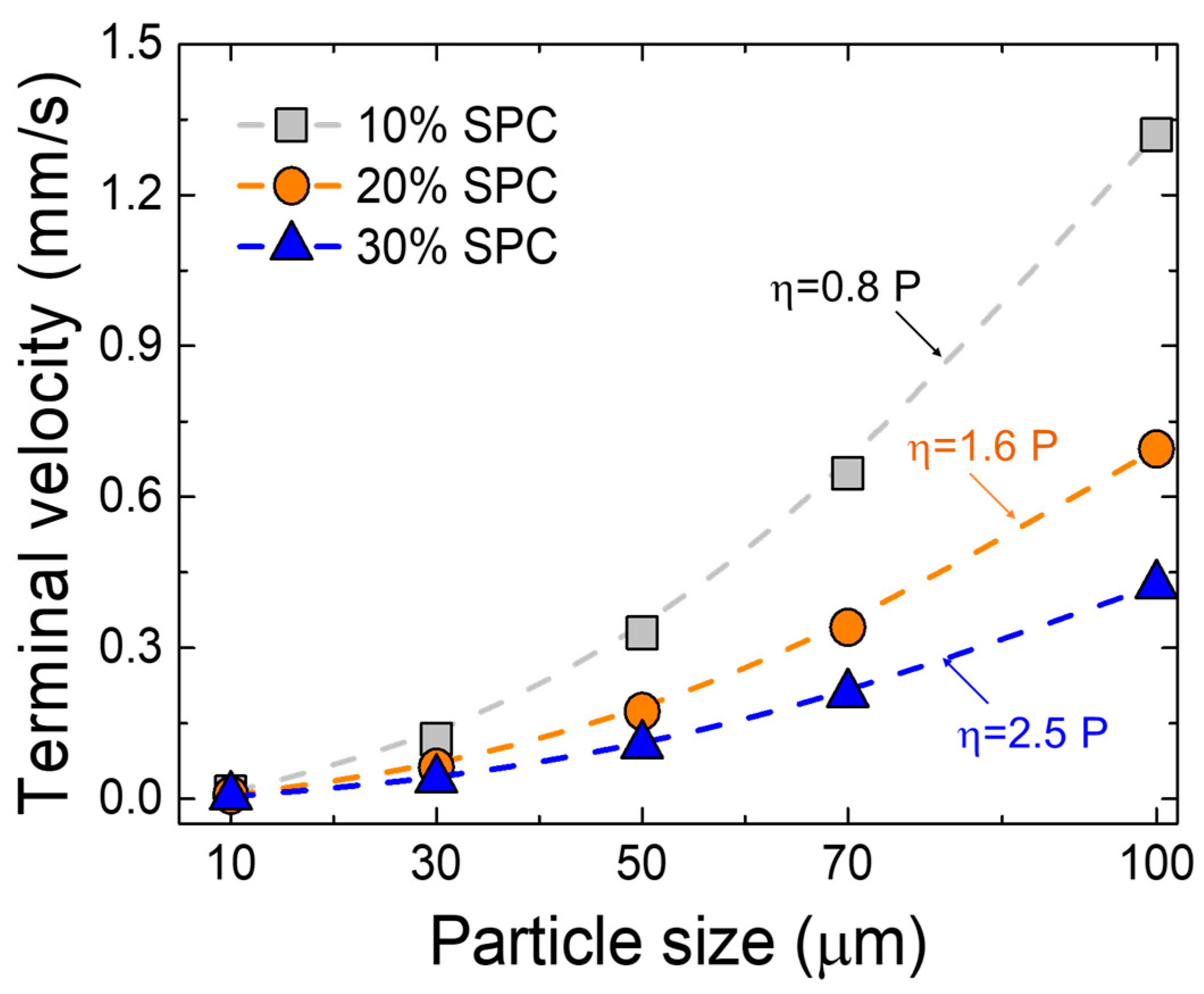

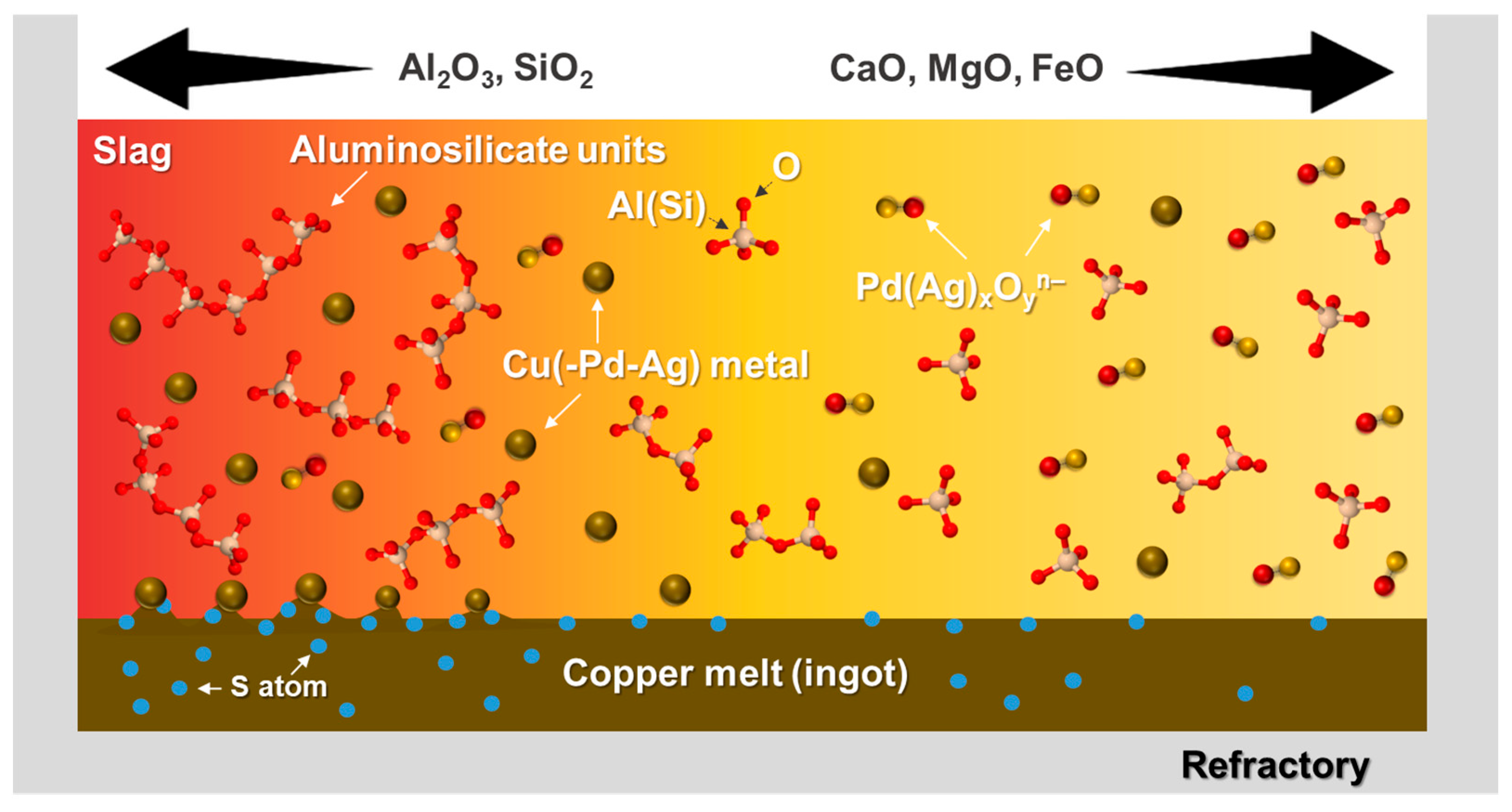
| Al2O3 | CaCO3 | Cu2O | Fe2O3 | SnO2 | P2O5 | SiO2 | MgO | C | S | Ag | Pd | |
|---|---|---|---|---|---|---|---|---|---|---|---|---|
| Copper sludge | 0.6 | 29.9 | 24.7 | 22.3 | 6.7 | 3.5 | 2.6 | 1.7 | 5.6 | 2.4 | 0.014 | - |
| Spent catalyst | 99.7 | - | - | - | - | - | - | - | - | - | - | 0.32 |
| Run ID | Metal Composition (wt%) | (ppm) | ||||||
|---|---|---|---|---|---|---|---|---|
| Cu | Fe | Sn | S | P | Pd | Ag | ||
| SPC 10% | Cu-rich phase | 71.45 | 20.27 | 7.25 | 0.61 | 0.36 | 410 | 150 |
| SPC 20% | Cu-rich phase | 79.41 | 9.95 | 9.03 | 0.82 | 0.59 | 710 | 1108 |
| Fe-rich phase | 17.38 | 72.24 | 0.18 | 0.27 | 9.93 | - | - | |
| SPC 30% | Cu-rich phase | 81.86 | 8.77 | 7.14 | 1.56 | 0.58 | 970 | 100 |
| Fe-rich phase | 20.44 | 68.79 | 0.45 | 0.36 | 9.96 | - | - | |
| Run ID | Slag Composition (wt%) | (ppm) | ||||||||
|---|---|---|---|---|---|---|---|---|---|---|
| T.Cu | MgO | Al2O3 | SiO2 | CaO | FeO | P2O5 | S | Pd | Ag | |
| SPC 10% | 0.63 | 6.8 | 20.1 | 5.4 | 52.4 | 7.0 | 5.6 | 2.1 | 0.1 | 0.2 |
| SPC 20% | 0.77 | 3.0 | 35.2 | 4.8 | 47.4 | 3.8 | 2.8 | 2.2 | 0.3 | 0.9 |
| SPC 30% | 1.79 | 3.0 | 46.5 | 2.8 | 35.5 | 5.3 | 2.3 | 2.8 | 60.0 | 1.0 |
Disclaimer/Publisher’s Note: The statements, opinions and data contained in all publications are solely those of the individual author(s) and contributor(s) and not of MDPI and/or the editor(s). MDPI and/or the editor(s) disclaim responsibility for any injury to people or property resulting from any ideas, methods, instructions or products referred to in the content. |
© 2025 by the authors. Licensee MDPI, Basel, Switzerland. This article is an open access article distributed under the terms and conditions of the Creative Commons Attribution (CC BY) license (https://creativecommons.org/licenses/by/4.0/).
Share and Cite
Kim, H.; Park, H.; Park, J. Recovery of Palladium and Silver from Copper Sludge and Spent Petrochemical Catalysts via Effective Pyrometallurgical Processing. Metals 2025, 15, 466. https://doi.org/10.3390/met15040466
Kim H, Park H, Park J. Recovery of Palladium and Silver from Copper Sludge and Spent Petrochemical Catalysts via Effective Pyrometallurgical Processing. Metals. 2025; 15(4):466. https://doi.org/10.3390/met15040466
Chicago/Turabian StyleKim, Hyunju, Hyunsik Park, and Joohyun Park. 2025. "Recovery of Palladium and Silver from Copper Sludge and Spent Petrochemical Catalysts via Effective Pyrometallurgical Processing" Metals 15, no. 4: 466. https://doi.org/10.3390/met15040466
APA StyleKim, H., Park, H., & Park, J. (2025). Recovery of Palladium and Silver from Copper Sludge and Spent Petrochemical Catalysts via Effective Pyrometallurgical Processing. Metals, 15(4), 466. https://doi.org/10.3390/met15040466








